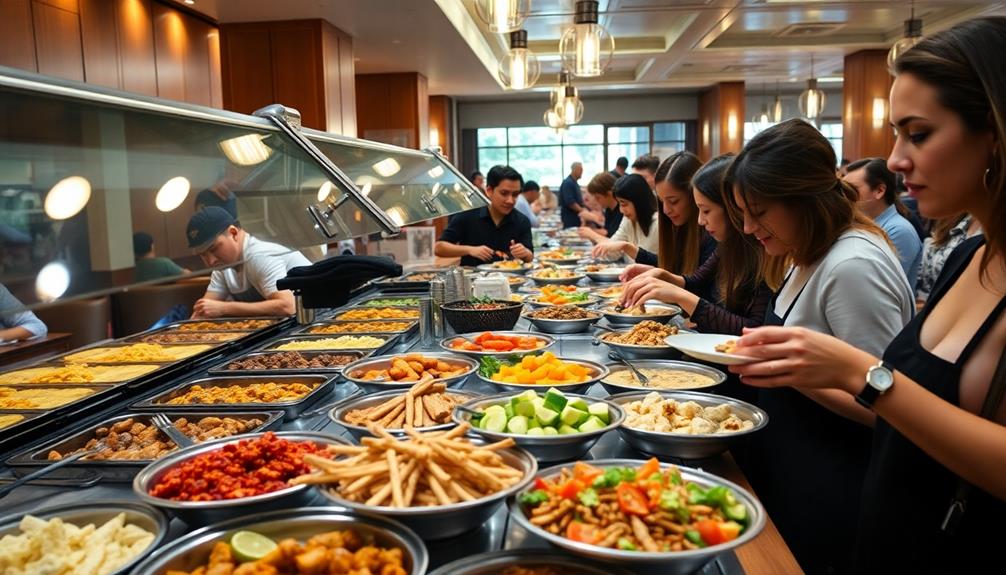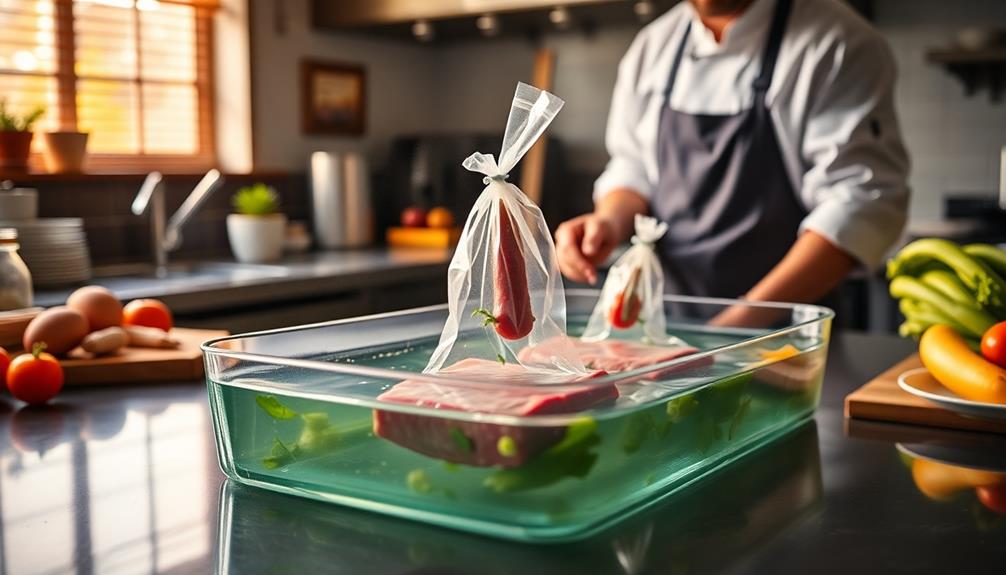All-you-can-eat buffets play on your psychology in fascinating ways. You might feel driven to overindulge due to the abundance mindset, pushing you to maximize your meal's value. Decision fatigue can arise from the overwhelming choices, leading to impulsive selections rather than thoughtful ones. Social dynamics also influence your plate size, as you often mirror your dining companions. While the joy of variety excites your taste buds, guilt can creep in after overindulgence. Understanding these psychological triggers can enhance your buffet experience, making it more enjoyable. There's a lot more to discover about how buffets shape your dining behavior.
Key Takeaways
- Abundance mindset drives overconsumption, with diners feeling compelled to maximize their value from the buffet experience, often leading to excessive portion sizes.
- Decision fatigue stems from overwhelming choices, creating stress and impulsivity in food selection, which can diminish overall dining satisfaction.
- Psychological triggers like appealing food presentation and constant visibility influence choices, often resulting in unintended overindulgence.
- Social dynamics play a significant role in buffet behavior, as individuals unconsciously mirror the eating habits of those around them, impacting portion sizes.
- Emotional responses in buffets range from joy of variety to guilt from overindulgence, shaping future dining habits and preferences.
Types of Buffet Eaters

At an all-you-can-eat buffet, you'll encounter a variety of diners, each with their own unique approach to the dining experience. The grab-a-plate and go-to-town type buffet customers plunge in without much thought, motivated by the perception of abundance. They sample numerous food choices, often leading to mindless eating as they pile their plates high.
This tendency can be seen in the context of various culinary traditions from around the world, where the allure of diverse flavors encourages exploration and indulgence, much like Asian Cuisine.
In contrast, the casually-walk-down-the-line type take their time, carefully observing their options. They prioritize quality over quantity, savoring each bite and making thoughtful selections that enhance their meal.
Then there are the on-a-diet buffet types, who struggle with the overwhelming variety of dishes. They tend to gravitate toward lighter fare, like salads and vegetables, all while trying to stick to their dietary goals.
The I-won't-touch-the-ladle type focus on hygiene, often using gloves or wipes to avoid direct contact with serving utensils. Their heightened awareness of cleanliness shapes their buffet experience.
Finally, you'll find the dessert-first type. They prioritize sweets over savory dishes, indulging their cravings upfront, which can notably alter their overall dining experience.
Each type offers a glimpse into the diverse ways people approach the buffet challenge.
Psychological Influences on Choices
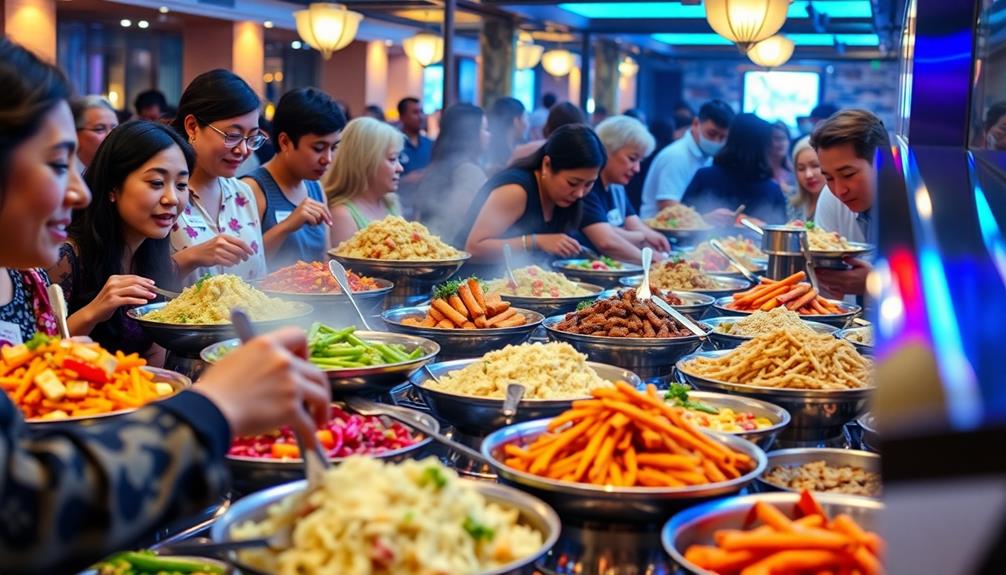
Buffets create a unique environment that considerably influences your food choices, often in unexpected ways. The abundance mindset that buffets foster can lead you to overconsume, driven by the urge to maximize the value of your fixed entry fee. You might find yourself piling your plate high, succumbing to the fear of missing out (FOMO) on the variety of options available, such as the temptation of delicious Turkey Sandwich leftovers. This desire to try everything often results in excessive portions.
As you navigate through a buffet, decision fatigue can set in. The overwhelming number of choices can create anxiety, pushing you to make impulsive decisions about what to eat. You may grab items without truly considering whether you really want them.
Moreover, psychological triggers play a significant role in your choices. The constant visibility of food, combined with its appealing presentation, can override your rational decision-making. You may end up eating more than intended, influenced by what you see rather than what your body needs. Furthermore, the psychology behind comfort food is a powerful force in shaping our eating habits. When we are feeling stressed or overwhelmed, the appeal of familiar, comforting foods can lead us to indulge in unhealthy options, further impacting our choices. This emotional connection to food can make it difficult to resist, even when we know that it may not be the best choice for our overall well-being.
Social dynamics also impact your choices, as you might unconsciously mirror the eating behaviors of those around you, leading to larger portion sizes.
Observational Behaviors at Buffets
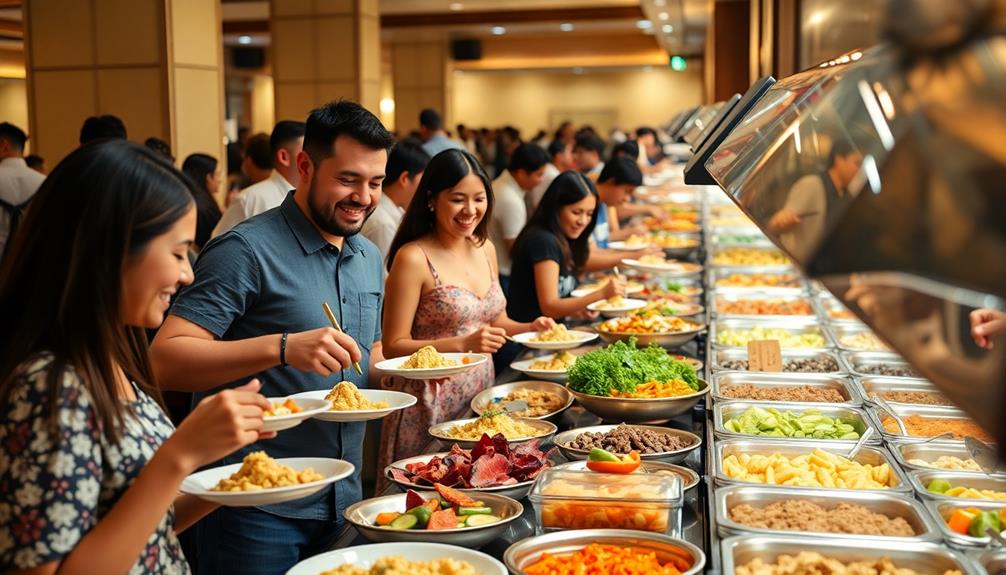
When you enter a buffet, your behavior can reveal a lot about your eating habits. Observational studies show that if you have a higher Body Mass Index (BMI), you mightn't take the time to browse the buffet before serving yourself. This often results in larger portion sizes, as you're more likely to dive right in. The psychology behind this suggests that impulse plays a significant role in your choices.
Additionally, the presence of appealing dishes, such as a flavorful Caldeirada or vibrant salads, can entice you to serve yourself more than you typically would. Curiously, the utensils you choose can also impact your consumption. Using chopsticks typically leads to lower consumption rates compared to forks, illustrating how simple changes can influence how much you eat.
Behavioral patterns indicate that less than 10% of food at buffets goes uneaten, highlighting a strong tendency to maximize your consumption.
Group dynamics further complicate your eating habits. When you're surrounded by others, social cues can lead you to increase your portion sizes and adjust your food choices based on what they're selecting.
Emotional Responses to Dining
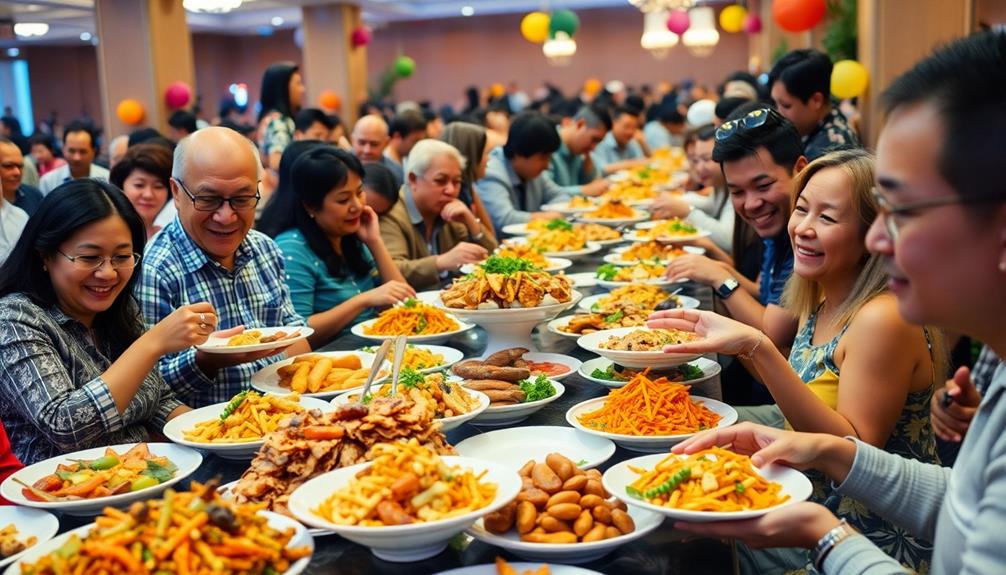
When you step into an all-you-can-eat buffet, you might feel a rush of joy at the endless variety of food options available, much like the excitement of discovering a fresh ingredient dish that highlights seasonal produce.
Yet, that excitement can quickly turn to anxiety as you grapple with making choices, and it's easy to overindulge, leaving you with a nagging sense of guilt afterward.
Balancing the thrill of variety with the weight of guilt and decision fatigue creates a complex emotional landscape that many diners navigate.
Overindulgence and Guilt
Overindulgence at all-you-can-eat buffets can lead to a whirlwind of emotional responses, particularly guilt and regret. When you fill your plate to the brim at the buffet line, it's easy to lose track of your intended portion sizes. This often results in feelings of discomfort after the meal.
You might experience:
- Guilt: After overindulging, you may feel remorse for not exercising self-control, wondering why you couldn't resist those extra helpings. This guilt can be compounded by the awareness of healthier, more balanced options available, such as Candy Corn Fruit Parfaits that offer a guilt-free sweet treat.
- Regret: You might look back and wish you'd made healthier choices or simply eaten less, leading to dissatisfaction with your dining experience.
- Anxiety: The constant visibility of food options can heighten stress, making it hard to resist the urge to overconsume.
Additionally, disappointment can creep in if your desired dishes aren't available or don't meet your expectations.
The frustration of maneuvering through crowded buffet lines can also amplify your emotional responses, leaving you feeling overwhelmed.
Ultimately, this combination of factors complicates your dining experience, making it a challenge to enjoy the variety without succumbing to guilt.
Joy of Variety
The joy of variety at an all-you-can-eat buffet can transform your dining experience into an exciting culinary adventure. When you walk in, the sight of diverse food options ignites your excitement and anticipation. Each dish presents an opportunity to indulge in something new or revisit a favorite, creating a sensory feast that tantalizes your taste buds and lifts your mood.
This abundance not only satisfies your cravings but also plays a significant role in your emotional response to dining. Many buffets may include comforting Southern dishes like satisfying fried pork chops, which add a familiar warmth to the experience.
You might feel sheer joy as you explore different cuisines, relishing the freedom to sample whatever you desire. The quality of the food can enhance this experience, making every bite a delight.
Dining at a buffet allows you to fill your belly as cheaply as possible, letting you savor a wide range of flavors without breaking the bank. Cultural backgrounds also influence your joy of variety, shaping what you find exciting or comforting.
Ultimately, the thrill of choice creates a unique atmosphere that can elevate your meal, making buffets a favorite for those seeking indulgence and culinary exploration.
Anxiety From Choices
While the joy of variety can be exhilarating, it often brings a different emotional response: anxiety from choices. Standing before an endless array of dishes, including options like Red-Braised Pork Belly and Sichuan Cold Noodles, you might feel overwhelmed, leading to decision fatigue.
This emotional turmoil can manifest in several ways:
- Overindulgence: You may feel pressured to sample everything, afraid of missing out on a delicious dish. This can lead to a plate piled high, and afterward, you might wrestle with feelings of guilt.
- Social Pressure: Watching others choose can heighten your anxiety. You might feel compelled to mimic their selections, even if they don't align with your preferences, complicating your dining experience.
- Environmental Distractions: The noise and hustle of a busy buffet can intensify your frustration. Waiting in line or maneuvering through crowds only adds to the stress, making it harder to focus on what you genuinely want to eat.
In the end, while buffets offer an enticing variety, the anxiety from choices can overshadow the experience, leaving you feeling frazzled rather than satisfied.
Understanding this dynamic can help you manage the buffet with more confidence and enjoyment.
Social Dynamics in Buffet Settings
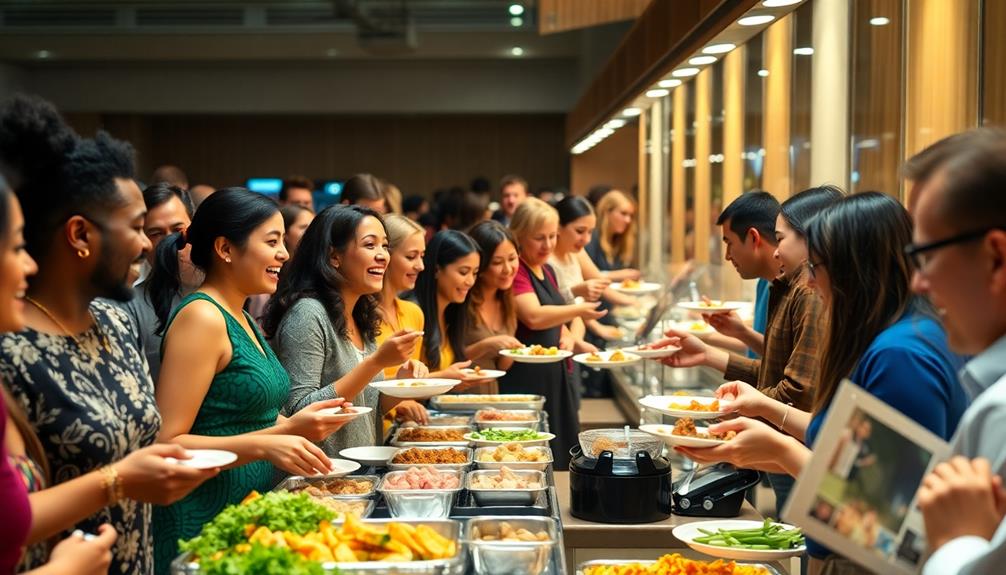
In buffet settings, social dynamics play an essential role in shaping your dining experience. You might notice that group behaviors often lead to competitive eating patterns, especially when diners aggressively go for the last servings. This competitive atmosphere can trigger a rush, impacting how much you enjoy your meal.
Those with higher patience levels tend to savor their food more, allowing for a more satisfying experience. The variety of dishes available, such as Chilaquiles, can also influence choices as diners may feel compelled to try a bit of everything.
The presence of peers can greatly influence your dietary decisions. You may feel pressured to conform to the eating habits of your companions, which can lead to increased portion sizes. This shared experience can enhance enjoyment, but it can also spark conflicts, particularly when preferences clash or one group monopolizes certain dishes.
Cultural etiquette further shapes buffet interactions. Depending on your background, you might approach food selection and sharing differently than others.
Understanding these social dynamics can help you navigate the buffet more effectively, allowing you to balance enjoyment and portion sizes while minimizing potential conflicts. Being aware of these factors can enhance your overall experience and make for a more enjoyable meal with others.
Profitability Challenges for Buffets
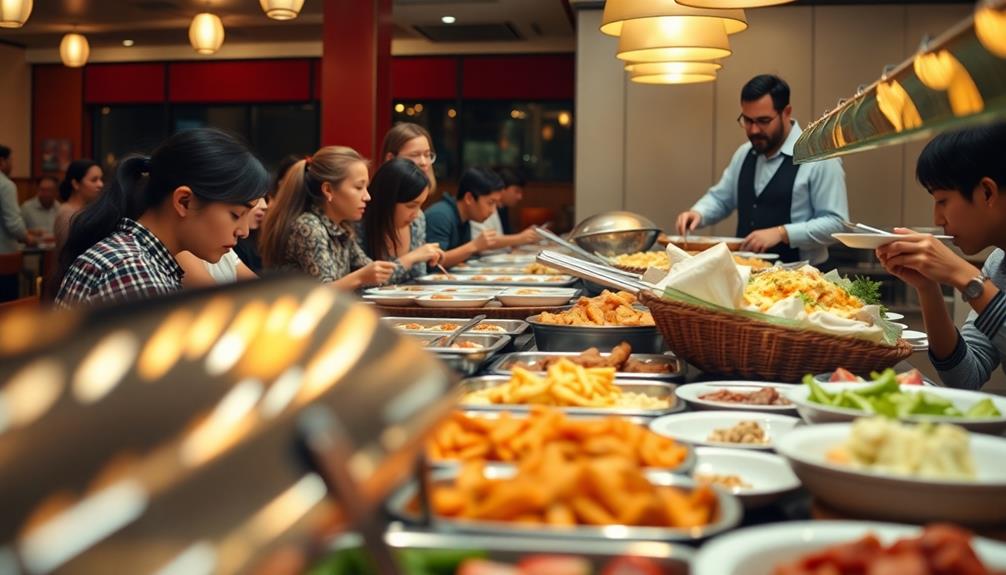
When you think about all-you-can-eat buffets, consider how tight their profit margins really are—often just a few dollars on a hefty bill.
The intense competition forces these establishments to get creative with their strategies, from managing food waste to adjusting menu prices.
For instance, many buffets might include popular dishes like Mushroom Masala to appeal to vegetarian customers while keeping costs manageable.
Understanding these challenges helps you appreciate the balance buffets strike between customer satisfaction and financial sustainability.
Profit Margins Overview
All-you-can-eat buffets face significant profitability challenges, often operating on razor-thin margins. With an average profit margin of just 3%, or $1.07 on a $40 bill, it's clear that maintaining profitability isn't easy.
Many establishments, especially in Las Vegas, rely on gambling revenue to offset their food operation losses, further complicating their financial landscape. Buffets often include popular comfort foods like loaded baked potatoes to attract customers, as these items are both satisfying and cost-effective.
To thrive, successful all-you-can-eat buffets need to balance customer satisfaction with cost control. Here are three key strategies they use to improve profit margins:
- Minimizing Food Waste: By carefully managing portion sizes and popular dishes, buffets can reduce waste and maximize the value of ingredients.
- Dynamic Pricing: Implementing higher prices during peak times can enhance the patron experience while improving profitability.
- Loyalty Programs: Offering discounts or incentives for repeat visits fosters customer loyalty, ensuring a steady flow of patrons.
In this challenging environment, buffets that prioritize these strategies can navigate the complexities of customer satisfaction while safeguarding their profit margins.
The robust market for all-you-can-eat buffets, especially in cities like Houston, demonstrates that with the right approach, success is attainable.
Competition and Strategies
Maneuvering through the competitive landscape of all-you-can-eat buffets can be intimidating, especially with so many options vying for your attention.
The buffet model often operates on thin profit margins, averaging just $1.07 profit on a $40 bill. This means buffets must employ strategic approaches to overcome profitability challenges.
In cities like Houston, where the demand for buffet dining remains strong, successful establishments balance customer satisfaction with cost control. They creatively manage menu offerings and food waste strategies to maximize profits while keeping diners happy.
Competition forces buffets to think outside the box. Many employ strategic pricing, placing high-cost items in less prominent areas to minimize consumption.
By ensuring food placement caters to diverse customer demographics, they enhance the overall dining experience without sacrificing profitability.
Despite the financial struggles faced by some, particularly in places like Las Vegas where many buffets rely on gambling revenue, the right strategies can lead to success.
For you, understanding these dynamics can enhance your dining experience, as you'll see how buffets work hard to create a satisfying yet profitable environment.
Menu Design Strategies
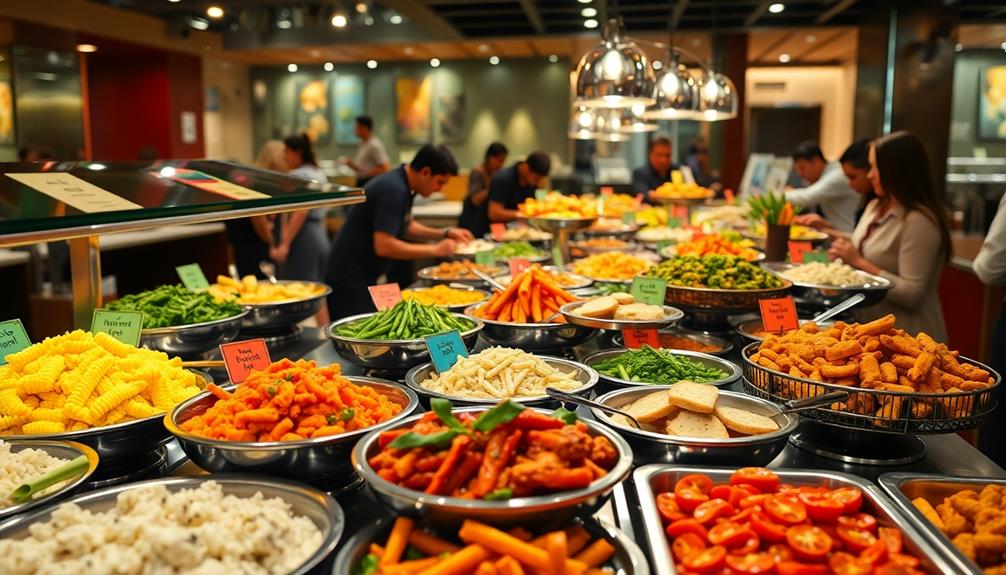
Strategically designed menus play a pivotal role in the success of AYCE buffets, balancing variety and cost-effectiveness. By leveraging smart menu design strategies, buffets can optimize their food items while adhering to the economics of all-you-can-eat.
Here are three key strategies they often use:
- Flexible Menu Adjustments: Buffets adjust their menus daily based on ingredient availability and cost, ensuring profitability and freshness.
- Strategic Food Placement: Filling items like rice and pasta are placed at the beginning of the buffet line, encouraging diners to load up on these cheaper options. More expensive proteins are positioned further down, limiting overconsumption.
- Portion Control Measures: Smaller plates and bowls help control how much food you take, effectively reducing overall consumption and minimizing waste.
Customer Behavior Patterns
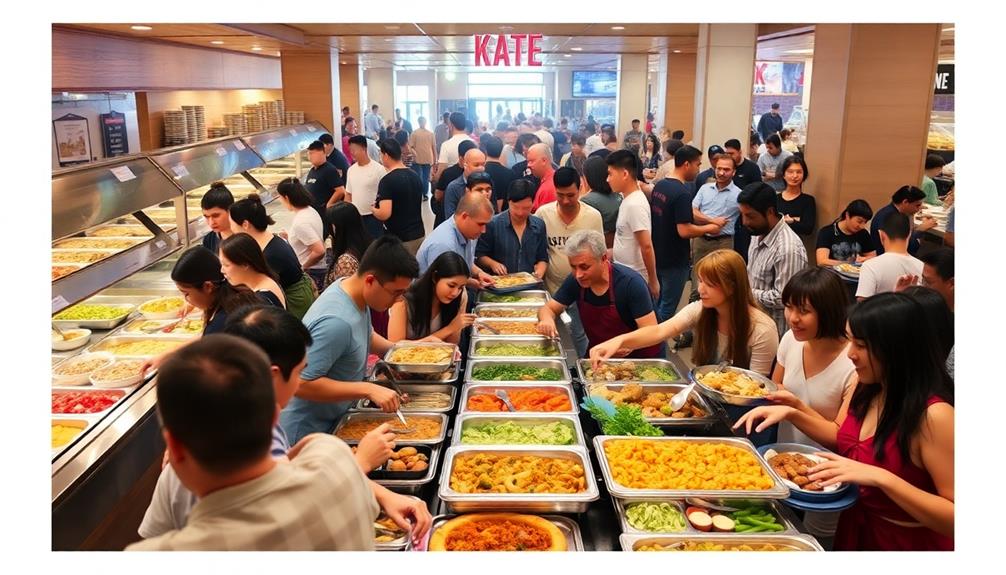
Many diners exhibit fascinating behavior patterns when traversing buffets, which can greatly influence their eating habits. For instance, those with a higher Body Mass Index (BMI) often dive straight in without browsing, leading to larger initial portion sizes. Behavioral cues in buffet design, like using smaller plates, can notably reduce the amount of food taken.
The table below highlights key customer behavior patterns in buffets:
| Behavior Pattern | Impact on Eating Habits |
|---|---|
| Browsing before serving | Smaller portion sizes |
| Using hands over utensils | Larger portion sizes |
| Group dining influence | Increased portion sizes |
| Buffet design (smaller plates) | Reduced overall consumption |
| Food wastage (less than 10% left) | Optimization of consumption |
Understanding these patterns can enhance your buffet experience. You'll notice how your choices are affected by those around you and how the layout influences your plate. By recognizing these behaviors, you can make more mindful decisions about your portion sizes and overall consumption while enjoying the variety a buffet has to offer.
Marketing Insights for Buffets
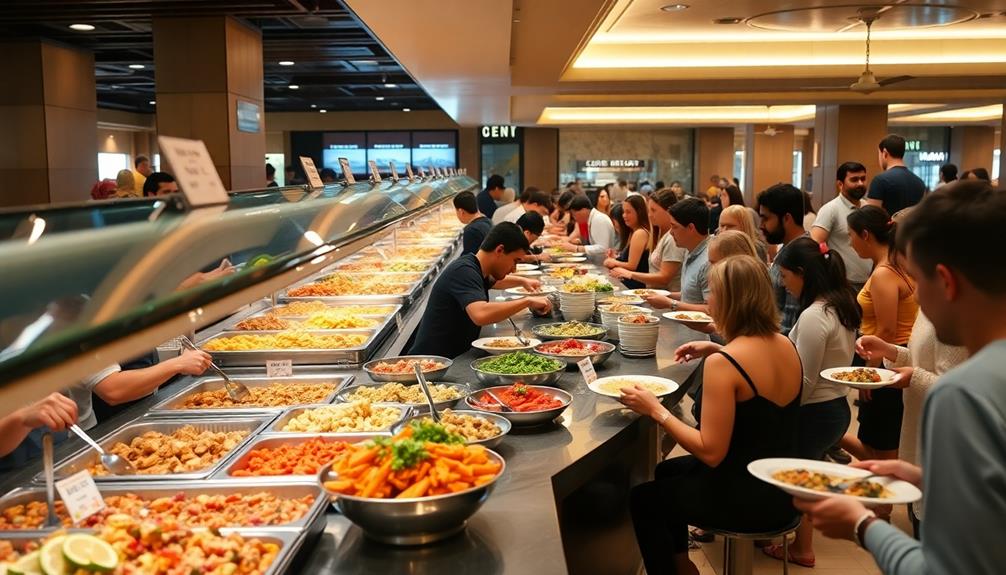
Buffets rely on clever marketing insights to maximize customer satisfaction and profitability. By strategically managing food and service, buffet managers can create an enticing experience while keeping costs in check.
Here are three key marketing strategies they employ:
- Smaller Plates and Bowls: Using smaller dishware limits the amount of food diners take, reducing waste and encouraging them to return for more rather than overloading their plates.
- Strategic Food Placement: Positioning filling items like rice and pasta at the start of the buffet line entices customers to fill up on lower-cost foods, maximizing profits.
- Pricing Tactics: Charging separately for soft drinks boosts profit margins greatly. This method helps balance out the average consumer's tendency to consume food costing less than the buffet price.
Frequently Asked Questions
What Are the Benefits of the All-You-Can-Eat Buffet?
At an all-you-can-eat buffet, you enjoy diverse cuisines, savoring new dishes without breaking the bank. The fixed price encourages you to indulge, making it perfect for family gatherings and social dining experiences with friends.
Why Do People Tend to Eat More at All-You-Can-Eat Buffet Restaurants?
Eating at an all-you-can-eat buffet feels like being a kid in a candy store. You see endless options, and the fixed price tempts you to load up, often ignoring your body's signals of fullness.
What Is the Meaning of All-You-Can-Eat Buffet?
An all-you-can-eat buffet means you can enjoy unlimited food for a fixed price. It offers a variety of dishes, encouraging you to explore different flavors and eat as much as you want.
Can an All-You-Can-Eat Buffet Cut You Off?
Yes, an all-you-can-eat buffet can cut you off. If you overindulge excessively or attempt to take food home, they might enforce their policies to maintain a balance between customer enjoyment and operational efficiency.
Conclusion
In exploring the psychology of all-you-can-eat buffets, you can see how your choices, emotions, and social interactions shape your experience. Picture yourself at a bustling buffet, your plate piled high with colorful dishes, driven by the thrill of value. As you savor each bite, you might notice how the atmosphere and your companions influence what you choose. Understanding these dynamics can enhance not just your dining experience but also the strategies that buffets use to keep you coming back for more.
